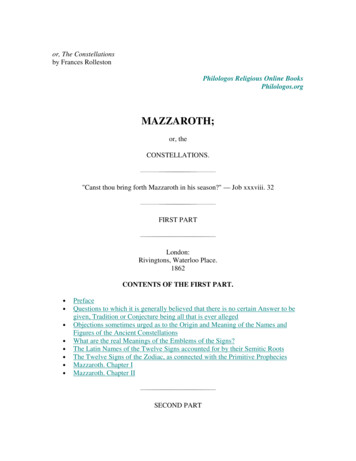
Transcription
Astronomy 101Basic AstronomyInstructor: Dr. Kevin Krisciunas
Textbook The Essential Cosmic Perspective, 8th ed.,by Bennett and coauthors.Supplementary reading A Guide to Wider Horizons,2nd edition, by Krisciunas. Three copies are on reserve atthe ground floor of the Evans Library annex. Themost relevant chapters are available from the coursewebsite.
Note the TAMU class website:people.physics.tamu.edu/krisciunas/astr101 fall20.htmland the website associated with our book:www.pearsonmylabandmastering.comThe course ID is “krisciunas66672” (09:20 class).For the 12:00 pm class the course ID for online homeworkis “krisciunas72984”.To phone Pearson support: 1-800-677-6337
Over the past 14 years here at Texas A&Malmost half of my students have earned an A or Bin basic astronomyWhat’s the nominal grading scale?80 to 100 A, 70 to 80 B, 60 to 70 C,50 to 60 D, less than 50 F.
How to maximize your grade in this class:Read the chapters ahead of time.Come to class.If you hear my spin on some topic, then you mightmore easily recognize the phraseology on a test.Study online quiz questions at the Mastering Astronomywebsite.
Why are you here (in this class, or at this university)?Possible reasons:1) To garner points and a grade2) Because you’re interested in astronomy3) Because learning makes life more fulfilling4) To figure out what you really want to do in life
In medieval universities students began with the trivium,which consisted of grammar, logic (also known asdialectic), and rhetoric.The quadrivium was considered preparatory work forphilosophy and theology. It consisted of arithmetic,astronomy, geometry, and music.Thus, astronomy has been an integral part of a well-roundededucation for centuries.
It helps to see how reason-based discovery of knowledge,starting in the Enlightenment period following the MiddleAges, led Thomas Paine and others to begin the “AmericanExperiment” that overthrew autocracy. The Key waseducation by the Seven Liberal Arts: the trivium: Grammar,Logic, Rhetoric, and the quadrivium: Algebra, Geometry,Astronomy, and Music. These lib-arts grew into countlessways to reason and invent. So we live in AC comforttraveling by GPS while listening by cell-phone to musicof centuries past (or gravity waves from black holes!)“Liberal” means liberation from superstition, illness,poverty, and slavery that liberal democracies promise. Butnow we see that for too many people those promises haveseemed too long coming and too difficult to keep.- Bill Harter, Univ. Arkansas Dept. of Physics
Five themes of basic astronomy:I. We are a part of the universe and thus can learnabout our origins by studying the universe.II. The universe is comprehensible through scientificprinciples that anyone can understand.III. Science is not a body of facts but rather a processthrough which we seek to understand the worldaround us.
IV. A course in astronomy is the beginning of a lifelonglearning experience.V. Astronomy affects each of us personally with the newperspectives it offers.Apollo 8 photo 12/24/68solar eclipse 7/11/91 (KK)
The Southern Crab Nebula (He 2-104), HST image.
Sunset at Cerro Tololo Observatory, Chile (T. Abbott).
An excellent website for interesting astronomicalimages is the Astronomy Picture of the Day:http://antwrp.gsfc.nasa.gov/apod/Aug. 12Perseids(FredBruenjes)
Night sky over the Grand Tetons (Wally Pacholka)
Scientists use the “meters-kilograms-seconds” (MKS)system of units or the “centimeters-grams-seconds (CGS)system of units.100 centimeters (cm) 1 meter1000 millimeters (mm) 1 meter1 micron (µm) one millionth (10-6) of a meter1 kilometer 1000 meters1 kilogram 1000 grams 2.2 pounds1 liter 1000 milliliters 1000 cubic centimeters
A Sense of Scaleproton10-15 mhydrogen atom10-10 mthickness of human hair 18 to 180 microns (10-6 m)human2mmedium sized town10 km (104 m)
Earth diameter1.28 X 104 km 107 mdistance from Earth to Sun1.5 X 1011 mdistances to nearest stars1017 msize of Milky Way galaxy 1021 mLocal Group of galaxies5 X 1023 mradius of observable universe 1.4 X 1026 mSometimes we like to use different units:1 mile 1.609347 kilometersmean Earth-Sun distance 1 Astronomical Unit1 light-year distance that light travels in one year (roughly6 trillion miles)
Since we all live on this planet, it is useful to knowthat the Earth is 8000 miles in diameter. The meandistance from the Earth to the Sun (the AstronomicalUnit) is 93 million miles (150 million km).It takes light 8.3 minutes to travel from the Sun tothe Earth.The distance light travels in one year is the unitcalled the light-year. The most distant quasars arebillions of light-years away. We are observing themas they appeared billions of years ago.
Astronomers also use angular units. One circlecontains 360 degrees. A right angle has 90 degrees.one degree 60 arcminutesone arcminute 60 arcsecondsso one degree 3600 arcseconds
The Moon subtends an angle of just over ½ degree. TheSun is just slightly smaller in angular size, on average.If they line up in the daytime sky, you see a total solareclipse.
As a holdover from the ancient Babylonians andEgyptians, minutes and seconds are designated inbase 60. For example, the latitude of this classroomis 30 degrees, 37' 14.8”. In decimal degrees thevalue would be30 37/60 14.8/3600 30.62078 degrees.Similarly, 41.70083 degrees is the same as41 deg 0.70083 X 60 '/deg 41 deg 42.05' 41 deg 42' 0.05 X 60”/' 41 deg 42' 03”
We can designate a direction in the sky from the “altitude”(or elevation angle) above the horizon, plus the “direction”(or azimuth angle) around the horizon.
The problem with using the “horizon system” ofcelestial coordinates is that the Earth's turns onits axis once a day.The Sun rises and sets each day.The Moon rises and sets each day.The stars also rise and set. Their principal apparentmotion is simply due to the rotation of the Earth.Thus, the elevation angle and the azimuth angle ofa celestial object as viewed from the Earth areconstantly changing.
At mid-northern or mid-southern latitudes somestars are always above your local horizon. Theyare called circumpolar stars.
For observers in mid-northern latitudes, the northernsky is like a large clock face.Knowing the day of the year, it is possible to use theorientation of the Big Dipper or some other circumpolarconstellation to determine your clock time. With youreyeballs, a protractor, and some relatively simple calculations, one can determine the clock time to within 10 minutes.
The star Polaris is very close to the direction of the NorthCelestial Pole, so it makes a very small circle in thenorthern sky.
Multiple choice question examples:What is the diameter of the Earth?A. 8000 kmB. 8000 milesC. 25,000 kmD. 25,000 miles
Say we build a highway that stretches all the wayaround the Earth’s equator. You get in a car andtravel 500 miles per day along this road. Howlong will it take you to complete one lap aroundthe planet?A. 16 daysB. 32 daysC. 50 daysD. 100 days
What is the brightest star in the night sky?a.b.c.d.SiriusPolarisBetelgeusethe star of Bethlehem
(Never mind the Sun .) Approximately how faraway are the nearest stars?a.b.c.d.several light-years awayseveral hundred light-years awayseveral thousand light-years awayseveral million light-years away
The elevation angle of Polaris above the north pointon the horizon gives you a good estimate of youra.b.c.d.longitudelatitudealtitudedeclination
Astronomy, and Music. These lib-arts grew into countless ways to reason and invent. So we live in AC comfort traveling by GPS while listening by cell-phone to music of centuries past (or gravity waves from black holes










